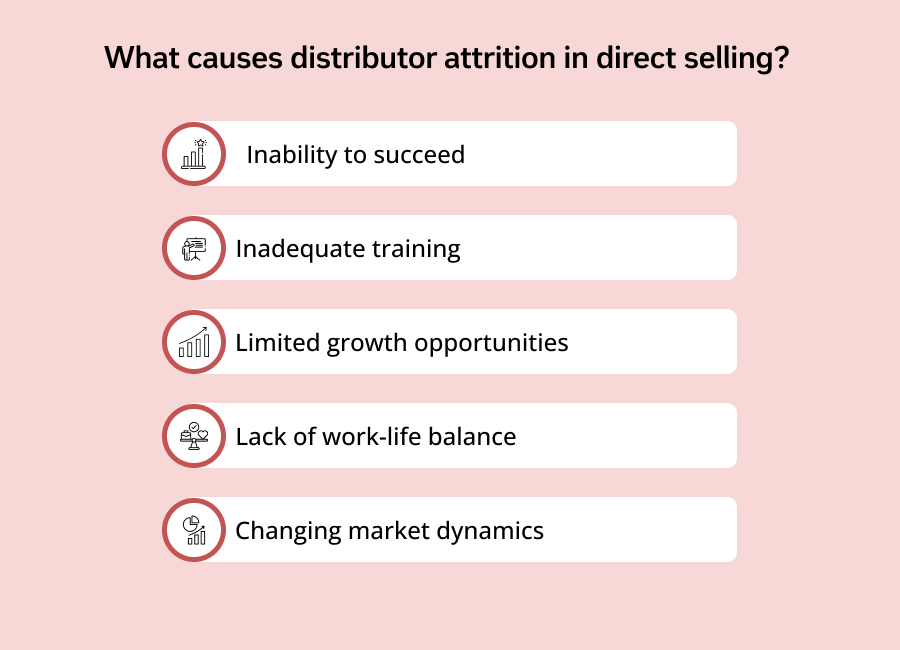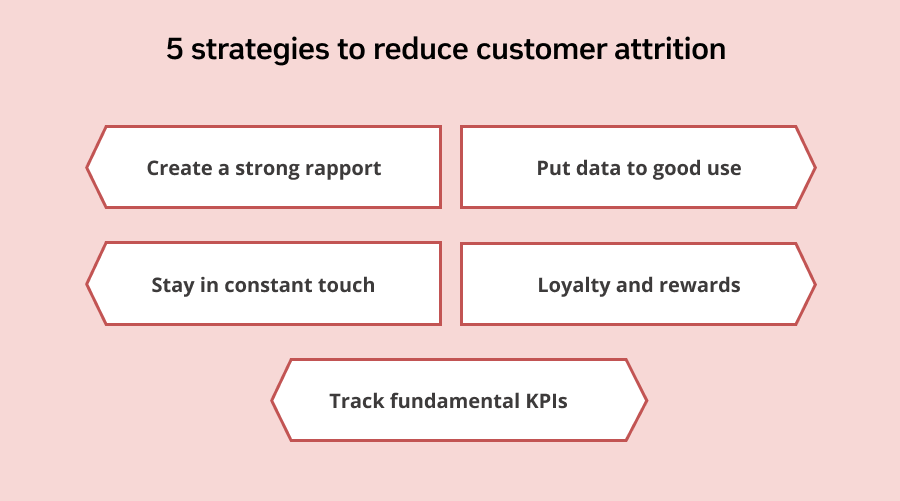Businesses are in a constant rat race to compete above their competitors, win, outgrow, and build concrete sales. Businesses small or big become successful only when the participants involved in them are happy and satisfied. That said, with direct selling businesses, the scenario is even more intense. Having a widespread network across the world, numerous distributors, uplines, downlines, and customers, who are the brand faces, keeping every individual in the business actively engaged and involved throughout their journey with the brand has got serious prominence.
Businesses often focus on boosting sales and profits and thus their marketing expenditure could be one major half of their revenue. If sales drop in a quarter, the advertising and marketing department focuses on intensifying their game hoping to achieve higher sales in the next quarter. But a reason that is often ignored or left unidentified is the number of participants leaving the business for various reasons or in other words, ATTRITION!
What is direct sales attrition?
Direct sales attrition, in simple terms, means the rate at which distributors leave a direct selling network or an organization owing to various reasons. The reason could be anything pertaining to the organization, industry or personal circumstances.
Let us briefly analyze the common reasons behind attrition in the direct selling industry and how to tackle them effectively. Understanding the reason behind a situation or a challenge in depth is indeed the first step towards solving it.

At Epixel, we curate personalized solutions for challenges that direct selling businesses face on a day-to-day basis. Our solutions, over the years, have resulted in minimizing attrition rates efficiently.
Key reasons behind attrition in the direct selling sector and the solutions to overcome the situation
Inability to succeed
In a direct selling network, each distributor’s sales and performances are monitored, exhibited, and considered, to create healthy competition. Or else, it could lead to distributors feeling left out when they don’t make enough income as their teammates.
Solution - In direct selling a thorough distributor onboarding process is important to ensure equitable opportunities. While a distributor gets onboard, it is crucial to give them an overall understanding of how much money would they earn as compensation and commission. Give them realistic expectations and not fancy figures and unrealistic promises. During distributor onboarding, give them a clear explanation of IDS (Income Disclosure Statement), to give them an overview of how their financial prospect will be during their journey with the brand.
Inadequate training
Many individuals take part in direct selling businesses considering it as a gig opportunity to earn a few extra dollars and some other to satisfy their entrepreneurial instincts. There could be students, housewives, professionals and non-professionals, who joins direct selling with and without having any idea of it. When a distributor is not given sufficient training, it could lead to low performances ideally pushing them to leave.
Solution - Training a distributor with the necessary skills to help them enhance their performance throughout their journey with the brand. This training wouldn’t be a one-time affair but a continuous process integrating fun factors like gaming modules and personalized training programs that would help them upskill and reskill their abilities in line with the business requirements and thus growing to new levels.
Limited growth opportunities
When a level one distributor continues to be at the same level for a longer period of time, it means that there are no growth opportunities for them to unlock their potential or to elevate to the next level in their direct selling career. Distributors tend to leave an organization when they don’t see themself growing gradually with the brand.
Solution - Growth is arbitrary. It differs from one person to another. However, understanding how each distributor perceives growth and how willing they are to imbibe a brand's ethics and beliefs, to grow in line with its vision, mission, and motto is where the distributor becomes the brand face. Integrate features like rank advancement where distributor growth can be rightly tracked and give them new commission and bonus opportunities as they scale through each level.
Giving distributors an opportunity to learn, to fail, to run trial and error, and encouraging them to take up challenges is where a distributor feels empowered enough to stay with the brand for the longest time.
Lack of work-life balance
Flexibility is a major factor that attracts people to direct selling businesses. Men, women, students, and people of all generations venture into direct selling considering the freedom it gives for its participants to operate at their convenience. But when they are pressurized to achieve unrealistic targets or stressed to outperform, it could contribute to higher attrition rates.
Solution - Give your distributors a breathing window between their work and personal lives. Prioritize their mental well-being and peace of mind over random sales figures and targets. Allow them to work under flexible arrangements and schedules with timely breaks to pause and resume at their desired hours but not letting the business impact negatively though. Rightly engaging distributors with skill-development activities helping them enable their performance is yet another way to lessen distributor attrition rates. Through team building and collaboration, distributors can also understand their capabilities better and reinvent newer success possibilities to unveil diverse growth opportunities thus creating a stable work-life equilibrium.
Changing market dynamics
The direct selling industry is evolving rapidly. And so is the market shifting to new trends and varying customer preferences abruptly. If the organization isn’t equipped enough to keep up with the rising competition, it could result in distributors being unable to keep up with the market and maintain their customer base. As a result, they would either move to a more updated organization or leave the industry itself for good.
Solution - Understanding the changing market pulse is as important as maintaining the business itself. Integrating innovations like
- Marketing automation, to boost up your campaigns across all platforms all at once according to market fluctuations.
- Market research, to identify growth segments and devise proactive business strategies.
- Enterprise management, to gather real-time business insights that are decisive to understand the market movements with which an enterprise could cross all barriers and keep up with the pace at which the industry is growing.
Attrition, are they all the same?
Definitely not. Like how you leave a job and switch to other, attrition could also be of voluntary or involuntary. Let us briefly understand the types of attrition to get an idea of how various factors influences distributor attrition in the direct selling industry.

- Voluntary attrition — Type of attrition where a distributor decides to leave on their own owing to any of the key reasons we highlighted earlier. In case of voluntary attrition, organization can always take the liberty to request the distributor to stay back. Only if the reason for their exit is identified and sufficient solution is applied to retain distributors and reduce attrition rates.
- Involuntary attrition — This type of attrition occurs when the employee is being released from the company. It could be because the distributor couldn’t perform according to the organizational standards, or he or she couldn’t contribute to the sales or profit of the organization.
- Internal attrition — This occurs when distributors move from one network to another within the same direct selling company. This could be because the distributor think that they could perform well with other team based on their skills and abilities. This obviously isn’t a thing to worry because as long as they are not leaving the organization, it doesn’t impact the attrition rate.
- Demographic-specific — This is a type of attrition that takes place when people of a specific age group, gender, or ethnicity leave the organization owing to any reason. This again can be prevented if these distributors are rightly engaged, by understanding their interests and concerns according to their demographics and culture.
Turning off the turnover
While we are talking about direct sales attrition, another component as important as distributor attrition is the customer attrition or customer turnover. A customer could find ten times more reasons than a distributor to choose one brand over the other. Customer attrition rate high or low could easily impact the sales of direct selling businesses heavily.
Turning off the turnover needs a mix of dedicated customer service, improved product quality and proactive strategies. With distributors and customers, focusing on building efficient relationships are crucial to reduce the churn rate which are detrimental to the growth and profitability of a direct selling business.
How to efficiently reduce customer attrition rates?
Similar to what we discussed earlier to reduce distributor attrition rates; customer attrition rates can be lowered if direct selling organizations curate strategies to sharpen their customer relationships.

- Create a strong rapport — From curating personalized interactions to delivering outstanding customer experience through excellent customer service, maintain a strong communication channel with your customers to foster trust and customer loyalty.
- Stay in constant touch — Maintaining customer relationships is not a one-time affair. Brands should identify their customers’ preferences through regular feedback, reviews, surveys, and one-to-one conversations.
- Put data to good use — There's nothing that data can’t resolve, yes, more precisely with customer retention. Leverage data to understand how your customer expects you to treat them through your products and services. A brand that best knows its customers sure gets to travel the longest with its customers.
- Loyalty and rewards — Customers are spoilt for choices. If you can’t give them something according to their choice, ten others would be willing to deliver the same in no time, right at their doorstep. Therefore, it is important to retain your customers with loyalty and rewards programs that holds them back with the brand effectively and efficiently.
- Track fundamental KPIs —Keep a close-watch on the KPIs (Key Performance Indicators) related to customer attrition like CLTV (Customer Lifetime Value), repeat purchase rate, AOV (Average Order Value) etc. Track these markers to understand how the graphs are moving and at what pace.
Find out from our customers how our solutions give MLM businesses an edge and exceed customer expectations
Devising strategies to curtail attrition cannot be done at once. It could change with varying market scenarios and most importantly changing human perspectives. Minimizing attrition rates requires constant intervention with every business attribute that is directly proportional to the growth and success of a direct selling business.
Stay in constant commitment with your distributors and customers to make the best use of their dedication to the brand to the farthest.
An ecommerce MLM business enhanced its distributor capabilities with top-notch engagement activities.
Read Case Study➔








Leave your comment
Fill up and remark your valuable comment.